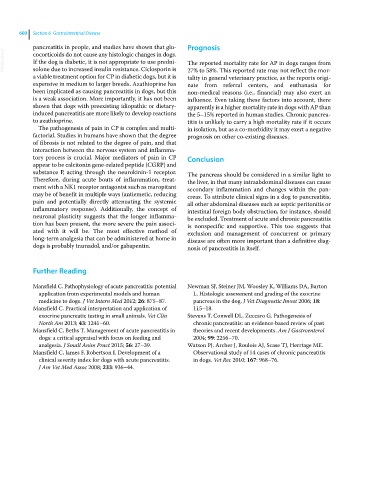Page 632 - Clinical Small Animal Internal Medicine
P. 632
600 Section 6 Gastrointestinal Disease
pancreatitis in people, and studies have shown that glu- Prognosis
VetBooks.ir cocorticoids do not cause any histologic changes in dogs. The reported mortality rate for AP in dogs ranges from
If the dog is diabetic, it is not appropriate to use predni-
solone due to increased insulin resistance. Ciclosporin is
a viable treatment option for CP in diabetic dogs, but it is 27% to 58%. This reported rate may not reflect the mor-
tality in general veterinary practice, as the reports origi-
expensive in medium to larger breeds. Azathioprine has nate from referral centers, and euthanasia for
been implicated as causing pancreatitis in dogs, but this non-medical reasons (i.e., financial) may also exert an
is a weak association. More importantly, it has not been influence. Even taking these factors into account, there
shown that dogs with preexisting idiopathic or dietary‐ apparently is a higher mortality rate in dogs with AP than
induced pancreatitis are more likely to develop reactions the 5–15% reported in human studies. Chronic pancrea-
to azathioprine. titis is unlikely to carry a high mortality rate if it occurs
The pathogenesis of pain in CP is complex and multi- in isolation, but as a co‐morbidity it may exert a negative
factorial. Studies in humans have shown that the degree prognosis on other co‐existing diseases.
of fibrosis is not related to the degree of pain, and that
interaction between the nervous system and inflamma-
tory process is crucial. Major mediators of pain in CP Conclusion
appear to be calcitonin gene‐related peptide (CGRP) and
substance P, acting through the neurokinin‐1 receptor. The pancreas should be considered in a similar light to
Therefore, during acute bouts of inflammation, treat- the liver, in that many intraabdominal diseases can cause
ment with a NK1 receptor antagonist such as maropitant secondary inflammation and changes within the pan-
may be of benefit in multiple ways (antiemetic, reducing creas. To attribute clinical signs in a dog to pancreatitis,
pain and potentially directly attenuating the systemic all other abdominal diseases such as septic peritonitis or
inflammatory response). Additionally, the concept of intestinal foreign body obstruction, for instance, should
neuronal plasticity suggests that the longer inflamma- be excluded. Treatment of acute and chronic pancreatitis
tion has been present, the more severe the pain associ- is nonspecific and supportive. This too suggests that
ated with it will be. The most effective method of exclusion and management of concurrent or primary
long‐term analgesia that can be administered at home in disease are often more important than a definitive diag-
dogs is probably tramadol, and/or gabapentin. nosis of pancreatitis in itself.
Further Reading
Mansfield C. Pathophysiology of acute pancreatitis: potential Newman SJ, Steiner JM, Woosley K, Williams DA, Barton
application from experimental models and human L. Histologic assessment and grading of the exocrine
medicine to dogs. J Vet Intern Med 2012; 26: 875–87. pancreas in the dog. J Vet Diagnostic Invest 2006; 18:
Mansfield C. Practical interpretation and application of 115–18.
exocrine pancreatic testing in small animals. Vet Clin Stevens T, Conwell DL, Zuccaro G. Pathogenesis of
North Am 2013; 43: 1241–60. chronic pancreatitis: an evidence‐based review of past
Mansfield C, Beths T. Management of acute pancreatitis in theories and recent developments. Am J Gastroenterol
dogs: a critical appraisal with focus on feeding and 2004; 99: 2256–70.
analgesia. J Small Anim Pract 2015; 56: 27–39. Watson PJ, Archer J, Roulois AJ, Scase TJ, Herrtage ME.
Mansfield C, James F, Robertson I. Development of a Observational study of 14 cases of chronic pancreatitis
clinical severity index for dogs with acute pancreatitis. in dogs. Vet Rec 2010; 167: 968–76.
J Am Vet Med Assoc 2008; 233: 936–44.

